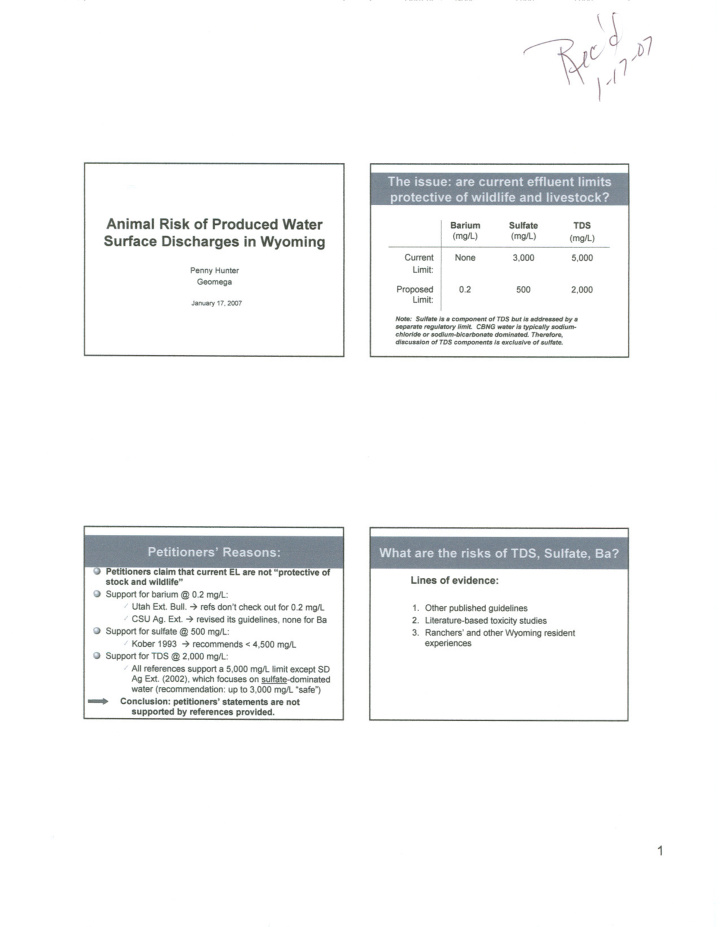



~~~1}1 )A Animal Risk of Produced Water Barium Sulfate TDS (mg/L) (mg/L) (mg/L) Surface Discharges in Wyoming None Current 3,000 5,000 Limit: Penny Hunter Geomega 0.2 500 2,000 Proposed Limit: January 17, 2007 Note: Suffate Is a component of TDS but Is addressed by a separate regulatory limit CBNG water Is typically sodium- chloride or sodium-bicarbonate dominated. Therefore, of TDS components is exclusive of sulfate. discussion Petitioners claim that current EL are not "protective of Lines of evidence: stock and wildlife" 0 Support for barium @ 0.2 mg/L: / UtahExt.Bull.-7 refsdon'tcheckoutfor 0.2 mg/L 1. Other published guidelines / CSUAg. Ext.-7 reviseditsguidelines,nonefor Ba 2. Literature-based toxicity studies 0 Supportfor sulfate @ 500 mg/L: 3. Ranchers' and other Wyoming resident / Kober1993 -7 recommends < 4,500 mglL experiences 0 Supportfor TDS@ 2,000 mglL: / All referencessupporta 5,000 mg/L limit except SD Ag Ext. (2002), which focuses on sulfate-dominated water (recommendation: up to 3,000 mg/L .safe") Conclusion: petitioners' statements are not supported by references provided. 1
0 Barium: .., / 5 - 300 mg/L livestock WQ guideline (Canada) / 20 - 100 ppm livestock (NRC 1980, 2005) . 0 Sulfate: :J! / 1,000 - 3,000 mg/L livestockWQ (Canada) c SUOllllfted 0 "'-11<: Q. .. ~ / 2,500 mg/L feedlotted cattle (NRC 2005) Geomebic mean I;) TDS: RiskMoreLikely / 5,000 -15,000 mg/L livestock (EPA 1976) """ ;; / 5,000 mg/L livestock (NRC 1974) . - --- LOAEL NOAEL II"'" Existing guidelines are supportive of current limits, Dose but do not support proposed changes to limits. Nonruminant Ruminant Ruminant Waterfowl 1;) Wyoming conditions differ from toxicity studies ~ mammal (growing (aduit steer) 8. (mallard) / JohnsonandPatterson (2004) (rodent) heifer) ~ I I;) Adaptation I inc'd tolerance can occur w/o long-term Barium 100 13 N/A- 360 .!! adverse effects (mgIL)* f / NRC (1974), Spafford (1941), Ballantyne (1957) I Sulfate 1 5,070* 5,100 3,010 4,590 I;) Toxicity study limitations (NOAEL vs LOAEL) (mglL) TDS 7,460 7,800 N/A- 5,680 ,II'" Ranchers in Bighom and Powder River basins weigh in (mgIL) Thanks to:Flitners, McCarty, Patterson, Shepperson, Schiaf, / Mikie,and others "lowest coneen",",on derived 10<each .scepto. ,hown. "N/A Not applioab~. No 'o~oity stud;e, ex'" to< "'.. type 01 "oepto. 2
Q No adverse effects on G Flitners: 7-year weaning rate averages as good or livestock (cattle, sheep, better on land wI produced water (2,700 mg/L S04, horses) that drank water 5,000 mg/L TDS) containing: Sulfates S 3,100 mglL 0 Mr. McCarty: No adverse effects on land wI produced / / TDSS5,390 mgIL water (3,100 S04; 5,390 TDS); body condition, mortality, weaning rateslweights, breeding rate Q Adverse effects apparent when exposed to: G Meike,SChlaf,Shepperson: No adverse effects / Sulfates" 4,000 mglL 0 Letters- Garland, Grabbert, Mantle, Pattison, Shultz, TDS" 7,000 mglL / Wilsons, Baird, McCarty, F.OAL, etc. 0 Loch Katrine / No adverse effects on Benchmark/Limit Barium Sulfate TDS wildlife at Loch Katrine mglL mg/L mg/L from produced water Recommended 13 3,010 5,600 contributions of 5,000 m benchmark: TDS and 2,050 mg/L sulfate (Ramirez,USFWS 2002) Current effluent None 3,000 5,000 Q Ranchers' observations limit: Wildlife observed utilizing produced water / 0.2 500 Petition proposed 2,000 sources in greater densities than natural limit: sources, withoutadverse effects. Experiencesinthe fieldare supportive ofcurrent limits, but do not support proposed changes to limits. 3
.5ffect~ofeli minated pr9ci uce.ci.\~~ter )"X,/S,,',:;SU rface-d isc ~a1~.C'.,j'b~{11~lllf~~~~.fl Q Cottonwood Creek: 15 - 20% loss of cattle ($2 million) ~ Letters of beneficial use by Wyoming residents Q Dry Creek: 30 - 50% loss of cattle (-$0.6 million) Cattle,sheepherdslargely maintained byproduced watersourcesin / areas of Bighorn and Powder River basins; Q Salt Creek: 20 - 40% loss of cattle ($0.6 - 1.1 million) / Increased capacity for irrigated crop and pasturelands attributed to Q Hot Springs County - loss of cattle results in: produced water sources; / $3.3 million total economic output, / Wildhorse populations supported in Bighorn basin(F.OAL). / $645,000 annual labor income ~ Use attainability analyses1 / 8% loss of pasture Salt Creek discharges support >4,500head of cattle and 3,300 / I) Additional costs to ranchers to develop alt water sources head of sheep; Q lost revenue from tourism, hunting, fishing / Cottonwood Creek discharges support 2/3rds of all crop Q lost access to federal funding for loch Katrine production in the area; Wildlife; game species abundant in discharge areas - supports / tourism; loch Katrine enhanced byproduced watersupports / sensitivelthreatened species. 1GeneR. Goo'oe 2005. RETEC 2004. SWWRC et aI. 2002 Effects of reduced exploration and development: Geomega's analysis shows that current 0 Lost tax and export revenue to counties WDEQ effluent limits Dose no measurable Hot Springs County (HamiltonDome) = $28.7 million(1997 dollars); / adverse effect to the health and well-being of Natrona County (S. Casper Creek) = $3 million(2002 dollars). / domestic livestock and wildlife. and there ~ Lostjobs would be no incremental reduction in wildlife Dome) = 136 jobs, Hot Springs (Hamilton $4.1 million annual labor; / (Sail Creek fields) = or livestock iniurv if limits were changed to Natrona & Johnson counties $4.6 million ann. labor. / ~ Lost contributions to social programs the Detitioners' reguested limits. In addition, Hot Springs (HamiltonCome) = $1.4 millionfor schools, etc associated social and economic imDacts of / Natrona &Johnson counties (Salt Creek fields) = $2.9 millionproperty / reduced water discharges and/or reduced and severance tax. exploration and development ~ould be harmful to Wvomina residents. 4
References _.c.V..J."""""""'_UM""". 1997. -"'-''''''''''''LNootod<. -""'U"'.'" - Foot_"'''''''. -. EE1""."" Con. J.Comp. Mod. V<L sa.2''''''"257. CCR"'.1987 ","'T"''''''''~-'"""",~_CouoOI "'R__----- GoMR.-"'_'~.. HAF. "" 2005. Uoe_-"'"...,.,Spido, "'"' -~.""""._. F_"Y". -,~,P,S,,"'H.H._. 2004. E_oh"-'I''''M~''''~of~H~"''""m,,,,''''._. - ""'"'"."'. Soc.""'.Sd.55251. """".JA_"' "",_,.39-<2.F_'993. NRe. 1914. __T""''''''''''''''W_'''''''''- -_"'_W_.D.C. _R..-CouoOI. NRe. 1980. _T_"'_- -_"'''''''''.W_D.C. _R..- CouoOI. NRe.2005 ,T__of_. N.".,,,""""my"'''''"'''''. W_. D.C. N_.IR_I<hC~""'. No""~. P.2002. 0;'""" ""''''''''''M dO",""... ioto ,.w,om;"". U.S. - Wild.. _. _'0 SeN'"Coot,,,,,,,,", No"". R6I71=. """""'. WY. ,,",. RETEe.2004 Uoe__.'" "' R'" N"","" - -- """". SD,..."'2OO2. T"" """,,,,,,,,,,,,,,,--,,,,,,,,,,,,,,,,,,,,,,,- "'"''''"''''"'''....... _.W..1"'.""'_"""'-"--_J.Dop._.S._""~ 9IW<RC"..2OO2 ,ComponyUH_- _20. """W"'_R- eo.pomtioo. W""""""""'T_.I~.- -_Com_"C. us EPA. 197..""'''' """".. WO,"'. """" ofWotM H..."~ M""'''. W"",...~. D.C. J..,. 5
Recommend
More recommend